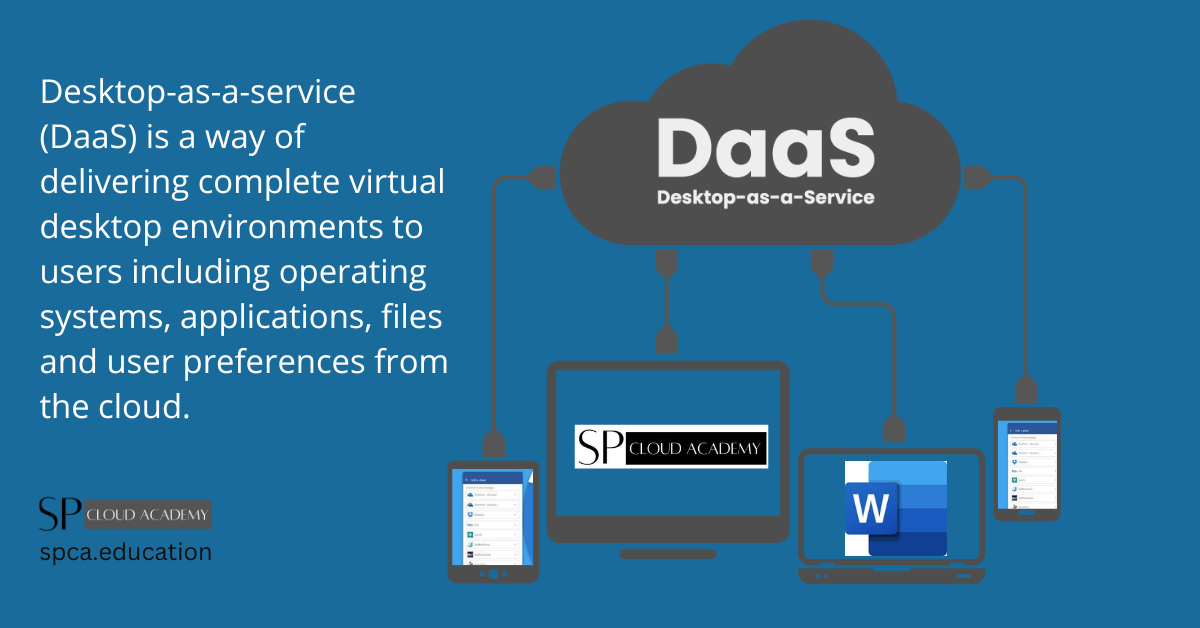In today’s fast-paced digital landscape, the concept of Desktop as a Service (DaaS) is revolutionizing the way businesses approach cloud computing. As organizations increasingly prioritize flexibility, scalability, and security, DaaS emerges as a formidable solution, offering a virtual desktop experience accessible from any device, anywhere. This article delves deep into the dynamic realm of DaaS, exploring its functionalities, benefits, and implications for modern businesses.
Understanding Desktop as a Service (DaaS) in Cloud Computing
Desktop as a Service (DaaS) is a cloud computing service that delivers virtual desktops to end-users over the internet. It is a form of virtual desktop infrastructure (VDI) that allows users to access their desktop environment from any device, eliminating the need for physical hardware constraints. By offloading the management and maintenance of desktop infrastructure to a cloud service provider, businesses can streamline IT operations and empower their workforce with greater mobility and flexibility. DaaS centralizes desktop management, making it easier for IT teams to deploy, update, and secure desktop environments across the organization.
DaaS solutions are designed to provide a seamless user experience, enabling employees to access their virtual desktops from any location with an internet connection. This flexibility is particularly valuable for remote and mobile workforces, as it ensures consistent access to essential applications and data without being tied to a specific physical workstation. With DaaS, businesses can embrace a more agile and adaptable approach to desktop computing, catering to the evolving needs of modern work environments.
The architecture of DaaS is built on a multi-tenant model, where multiple customers share the same infrastructure while maintaining isolation and security for their respective virtual desktop environments. This shared infrastructure allows DaaS providers to deliver cost-effective solutions, as the overhead costs are distributed across multiple clients. Additionally, DaaS providers handle the backend infrastructure, including server maintenance, security updates, and data backups, relieving businesses of the burden of managing complex IT resources.
Advantages of Desktop as a Service (DaaS)
The adoption of Desktop as a Service (DaaS) offers several compelling advantages for businesses seeking to modernize their desktop infrastructure and embrace the benefits of cloud computing. One of the primary advantages of DaaS is its ability to enhance workforce mobility and productivity. By providing employees with secure access to their virtual desktops from any location, DaaS empowers remote and mobile workers to remain productive without being tethered to a physical office space. This flexibility not only improves employee satisfaction but also enables businesses to tap into a broader talent pool without geographical constraints.
Another key advantage of DaaS is its scalability and agility. Unlike traditional desktop infrastructure, which requires substantial lead time and resources to deploy new desktops or upgrade hardware, DaaS enables businesses to rapidly scale their desktop environments based on demand. Whether it’s onboarding new employees, expanding into new markets, or accommodating seasonal fluctuations, DaaS provides the flexibility to adjust computing resources dynamically, ensuring that businesses can adapt to changing operational needs without incurring unnecessary costs or downtime.
In addition, DaaS simplifies IT management by centralizing the administration and maintenance of desktop environments. With DaaS, businesses can standardize desktop configurations, implement software updates, and enforce security policies across the entire organization from a single management console. This centralized approach not only streamlines IT operations but also strengthens security by ensuring consistent compliance with security protocols and access controls. Furthermore, the offloading of infrastructure management to DaaS providers allows businesses to redirect their IT resources towards strategic initiatives and innovation rather than routine maintenance tasks.
Key Features of Desktop as a Service (DaaS)
Desktop as a Service (DaaS) encompasses a range of key features that distinguish it as a powerful solution for delivering virtual desktop experiences in the cloud. One of the fundamental features of DaaS is its platform-agnostic nature, allowing users to access their virtual desktops from a variety of devices, including laptops, tablets, and smartphones. This device-agnostic approach ensures that employees can seamlessly transition between different devices without sacrificing the continuity of their desktop experience, promoting flexibility and productivity in diverse work environments.
Another essential feature of DaaS is its support for persistent and non-persistent desktops. Persistent desktops retain user-customized settings, applications, and data across sessions, providing a personalized experience akin to a traditional physical desktop. Non-persistent desktops, on the other hand, revert to a pristine state after each session, offering a clean and standardized environment for shared use cases, such as call centers or task-specific workflows. This flexibility allows businesses to align their desktop strategy with specific user requirements and operational workflows, optimizing the user experience and resource utilization.
DaaS also integrates robust security features to protect sensitive data and ensure compliance with industry regulations. Encryption, access controls, and multi-factor authentication mechanisms safeguard virtual desktops and data assets from unauthorized access and cyber threats. Additionally, DaaS providers implement regular security updates and patches to fortify the underlying infrastructure against emerging vulnerabilities, mitigating the risk of security breaches and data loss. By incorporating these security features, DaaS enables businesses to uphold the integrity and confidentiality of their digital assets while facilitating secure remote access for employees.
Implementing Desktop as a Service (DaaS) in Your Business
Implementing Desktop as a Service (DaaS) in your business involves a strategic approach to transition from traditional desktop infrastructure to a cloud-based virtual desktop environment. The first step in the implementation process is to assess the current desktop landscape and identify the specific use cases, user profiles, and application requirements within the organization. This assessment helps in determining the optimal DaaS deployment model, whether it’s a full-scale migration to cloud-hosted virtual desktops or a hybrid approach that integrates on-premises and cloud resources based on workload demands and regulatory considerations.
Once the requirements and deployment model are defined, businesses can evaluate DaaS providers and select a solution that aligns with their operational needs, budget constraints, and performance expectations. It’s essential to assess factors such as service reliability, data center locations, compliance certifications, and support for specialized applications to ensure that the chosen DaaS provider can meet the organization’s unique requirements. Additionally, businesses should consider the integration capabilities of the DaaS solution with existing IT infrastructure, including identity management, networking, and data storage, to facilitate a seamless transition and interoperability with current systems.
The next phase involves planning the migration and configuration of desktop workloads to the DaaS environment. This includes provisioning virtual desktops, transferring user profiles and data, and establishing connectivity between the DaaS solution and backend systems, such as file servers, databases, and enterprise applications. Proper testing and validation of the DaaS deployment are crucial to identify and resolve any compatibility issues, performance bottlenecks, or user experience concerns before transitioning to full production. User training and change management initiatives are also vital to prepare employees for the shift to a new desktop paradigm and ensure a smooth adoption process.
Security Considerations for Desktop as a Service (DaaS)
As businesses embrace Desktop as a Service (DaaS) to modernize their desktop infrastructure and enable remote work capabilities, it’s imperative to prioritize security considerations to safeguard sensitive data and mitigate cyber risks. DaaS providers implement a range of security measures to protect virtual desktop environments, including encryption of data in transit and at rest, network segmentation to isolate desktop instances, and identity and access management controls to enforce granular user permissions and authentication protocols.
Businesses should collaborate closely with their chosen DaaS provider to establish robust security policies that align with industry best practices and compliance standards. This includes defining access controls, data protection mechanisms, and incident response procedures to address security incidents or unauthorized access attempts. Regular security assessments and audits of the DaaS infrastructure are essential to validate the effectiveness of security controls and identify areas for continuous improvement to fortify the overall security posture of the virtual desktop environment.
Furthermore, employee awareness and training play a pivotal role in reinforcing security protocols and promoting a culture of vigilance against social engineering attacks, phishing attempts, and other cybersecurity threats. By educating users about safe computing practices, recognizing potential threats, and adhering to security guidelines, businesses can empower their workforce to become active participants in maintaining the security of their virtual desktops and data assets. Ultimately, a multi-layered approach to security, encompassing technical controls, policy enforcement, and user education, is paramount to fortifying the resilience of DaaS deployments against evolving cyber threats.
Cost Analysis of Desktop as a Service (DaaS) vs Traditional Desktop Infrastructure
Conducting a comprehensive cost analysis is essential for businesses considering the adoption of Desktop as a Service (DaaS) to evaluate the financial implications and potential savings compared to traditional desktop infrastructure. Traditional desktop infrastructure involves significant capital expenditures for hardware procurement, software licensing, and ongoing maintenance, as well as operational expenses for power consumption, cooling, and physical space requirements. In contrast, DaaS operates on a subscription-based model, offering predictable monthly costs and eliminating the need for upfront investments in physical hardware.
When calculating the total cost of ownership (TCO) for DaaS, businesses should consider factors such as the number of virtual desktops required, the performance specifications of virtual desktop instances, data storage capacity, network bandwidth requirements, and any additional services or support offerings provided by the DaaS provider. It’s crucial to conduct a thorough assessment of current desktop-related expenses and compare them with the projected costs of DaaS deployment, factoring in potential cost savings from reduced hardware refresh cycles, lower energy consumption, and minimized IT overhead associated with desktop management.
Additionally, businesses should weigh the indirect cost benefits of DaaS, such as improved productivity and workforce mobility, reduced downtime from desktop maintenance and troubleshooting, and the ability to rapidly scale desktop resources in response to business growth or operational changes. By quantifying both the direct and indirect cost implications, businesses can make informed decisions about the financial viability of transitioning to DaaS and identify opportunities to optimize their desktop computing expenditures while enhancing overall operational efficiency.
Best Practices for Desktop as a Service (DaaS) Deployment
To maximize the success of Desktop as a Service (DaaS) deployment and ensure a seamless transition to cloud-hosted virtual desktop environments, businesses should adhere to a set of best practices that encompass technical, operational, and organizational considerations. One of the fundamental best practices is to conduct a thorough assessment of existing desktop infrastructure, user requirements, and application dependencies to inform the design and implementation of the DaaS solution. This assessment helps in defining the scope of the DaaS deployment, identifying potential integration points, and establishing performance benchmarks for evaluating the success of the transition.
Engaging key stakeholders across IT, security, compliance, and end-user departments is critical to garner support and alignment for the DaaS initiative. By involving stakeholders early in the planning process, businesses can gain valuable insights into specific workflow requirements, security considerations, and user experience expectations, which are essential for tailoring the DaaS solution to meet diverse operational needs. Open communication and collaboration with stakeholders also foster a sense of ownership and engagement, driving successful adoption and utilization of the DaaS environment.
Furthermore, businesses should prioritize the implementation of robust data backup and disaster recovery mechanisms within the DaaS environment to safeguard against potential data loss or service disruptions. This involves defining backup schedules, retention policies, and recovery point objectives to ensure the resilience of critical data assets and maintain business continuity in the event of unforeseen incidents. Regular testing and validation of backup and recovery procedures are essential to validate the integrity and effectiveness of these measures, allowing businesses to mitigate the impact of data-related incidents and minimize downtime.
Case Studies: Successful Implementations of Desktop as a Service (DaaS)
Real-world case studies offer valuable insights into the tangible benefits and transformative impact of Desktop as a Service (DaaS) across diverse industry sectors. One such case study involves a global financial services firm that sought to modernize its desktop infrastructure to support a geographically dispersed workforce and enhance operational agility. By migrating to a DaaS solution, the firm achieved significant cost savings through reduced hardware investments and streamlined desktop management, while empowering employees to access their virtual desktops securely from any location, improving collaboration and productivity.
In another case study, a healthcare organization leveraged DaaS to address the challenges of maintaining compliance with stringent data privacy regulations and ensuring secure access to electronic health records (EHR) across its network of healthcare facilities. The DaaS deployment enabled the organization to centralize EHR access controls, enforce encryption of patient data, and implement multi-factor authentication, bolstering data security and regulatory compliance while enabling clinicians to access critical patient information seamlessly from various clinical settings.
Furthermore, a technology startup accelerated its go-to-market strategy and empowered its distributed development teams by adopting DaaS to provide developers with consistent and high-performance virtual desktop environments. This streamlined development workflows, reduced time-to-market for new software releases, and facilitated seamless collaboration across remote teams, demonstrating the agility and efficiency gains enabled by DaaS in a competitive technology landscape.
These case studies exemplify the diverse benefits and use cases of DaaS, showcasing how businesses across different industries have leveraged cloud-hosted virtual desktops to drive innovation, improve operational resilience, and empower their workforce with greater flexibility and mobility. By drawing insights from successful implementations, businesses can glean practical strategies and considerations for integrating DaaS into their own operational workflows and reaping the rewards of a modernized desktop environment.
Desktop as a Service (DaaS) Providers Comparison
Selecting the right Desktop as a Service (DaaS) provider is a critical decision for businesses seeking to leverage cloud-hosted virtual desktops to modernize their desktop infrastructure. When comparing DaaS providers, businesses should evaluate a range of factors to ensure that the chosen provider aligns with their operational requirements, performance expectations, and security considerations. One of the key considerations is the geographic presence of the DaaS provider’s data centers, as proximity to data centers can impact latency, data residency requirements, and regulatory compliance for businesses operating in specific regions.
Businesses should also assess the service level agreements (SLAs) offered by DaaS providers, including guarantees for uptime, performance, and support responsiveness. SLAs provide businesses with assurances of service reliability and establish accountability on the part of the DaaS provider to deliver consistent and high-quality virtual desktop experiences. Additionally, businesses should inquire about the scalability options and pricing models offered by DaaS providers to accommodate fluctuating desktop resource needs and align with budgetary considerations without incurring unexpected costs.
Security certifications and compliance adherence are paramount considerations when comparing DaaS providers, particularly for businesses operating in regulated industries such as healthcare, finance, or government. DaaS providers that maintain industry-recognized certifications for data security, privacy, and regulatory compliance demonstrate.
See also
Cloud Computing: https://spca.education/category/cloud-computing/
-

Battle of the Giants: Comparing AWS, Google Cloud, and Microsoft Azure Head-to-Head
-

Cloud 2025: Game-Changing Innovations Driving the Future of Technology
-

The Ultimate Cloud Hosting Handbook: Every Feature, Benefit, and Pitfall Explained
-

From Hardware to Apps: Mastering Every Type of Virtualization in Cloud Computing
-

Unlock the Sky: 10 Must-Read Books on Cloud Computing for Every Skill Level
-

Your Cloud Migration Just Got Easier: A Step-by-Step Decision Guide
